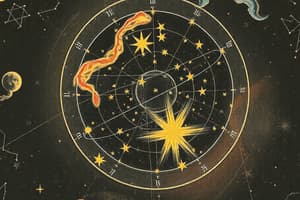Podcast
Questions and Answers
If someone is born in late December, under which Western Zodiac sign would they fall?
If someone is born in late December, under which Western Zodiac sign would they fall?
- Capricorn (correct)
- Sagittarius
- Scorpio
- Aquarius
Which Western Zodiac sign is represented by scales?
Which Western Zodiac sign is represented by scales?
- Virgo
- Sagittarius
- Libra (correct)
- Scorpio
How does the Chinese Zodiac differ fundamentally from the Western Zodiac?
How does the Chinese Zodiac differ fundamentally from the Western Zodiac?
- The Western Zodiac incorporates the Five Elements.
- The Chinese Zodiac incorporates animals and a yearly cycle, unlike the Western Zodiac. (correct)
- The Chinese Zodiac is associated exclusively with celestial constellations.
- The Chinese Zodiac is based on a 12-month cycle, while the Western Zodiac is based on a 12-year cycle.
What is the primary significance of the zodiac signs in astrology?
What is the primary significance of the zodiac signs in astrology?
Which of the following animals is not part of the Chinese Zodiac?
Which of the following animals is not part of the Chinese Zodiac?
What concept explains the shift in the apparent positions of zodiac constellations over extended periods?
What concept explains the shift in the apparent positions of zodiac constellations over extended periods?
How does the incorporation of the Five Elements affect the Chinese Zodiac?
How does the incorporation of the Five Elements affect the Chinese Zodiac?
How do tropical and sidereal zodiacs differ concerning the constellations?
How do tropical and sidereal zodiacs differ concerning the constellations?
If a newly discovered star is observed to have a reddish hue, what can be inferred about its surface temperature?
If a newly discovered star is observed to have a reddish hue, what can be inferred about its surface temperature?
Which constellation is known for containing Polaris, often referred to as the North Star?
Which constellation is known for containing Polaris, often referred to as the North Star?
A star is observed to have a very high absolute magnitude. What does this indicate about the star?
A star is observed to have a very high absolute magnitude. What does this indicate about the star?
Which of the following statements accurately describes the relationship between a star's mass and its lifespan?
Which of the following statements accurately describes the relationship between a star's mass and its lifespan?
After a star exhausts its hydrogen fuel, it enters the red giant phase. What is the primary process occurring in the star's core during this phase?
After a star exhausts its hydrogen fuel, it enters the red giant phase. What is the primary process occurring in the star's core during this phase?
What determines a star's eventual fate after it leaves the main sequence?
What determines a star's eventual fate after it leaves the main sequence?
What is the significance of the zodiac in astronomy?
What is the significance of the zodiac in astronomy?
A person is born on April 15th. According to the zodiac, which sign were they born under?
A person is born on April 15th. According to the zodiac, which sign were they born under?
Flashcards
Cancer (Zodiac)
Cancer (Zodiac)
A zodiac sign associated with those born between June 21 and July 22, symbolized by a crab.
Leo (Zodiac)
Leo (Zodiac)
A zodiac sign for those born July 23 - August 22, symbolized by a lion.
Virgo (Zodiac)
Virgo (Zodiac)
Zodiac sign spanning August 23 - September 22, often depicted as a maiden.
Libra (Zodiac)
Libra (Zodiac)
Signup and view all the flashcards
Zodiac Signs (Influence)
Zodiac Signs (Influence)
Signup and view all the flashcards
Chinese Zodiac
Chinese Zodiac
Signup and view all the flashcards
Animal Characteristics (Chinese Zodiac)
Animal Characteristics (Chinese Zodiac)
Signup and view all the flashcards
Chinese Zodiac (Cultural Use)
Chinese Zodiac (Cultural Use)
Signup and view all the flashcards
What is a constellation?
What is a constellation?
Signup and view all the flashcards
Name two constellations.
Name two constellations.
Signup and view all the flashcards
What are stars?
What are stars?
Signup and view all the flashcards
List 4 stellar properties.
List 4 stellar properties.
Signup and view all the flashcards
Describe stellar evolution.
Describe stellar evolution.
Signup and view all the flashcards
What happens in the Main Sequence?
What happens in the Main Sequence?
Signup and view all the flashcards
What is the zodiac?
What is the zodiac?
Signup and view all the flashcards
Name three zodiac signs.
Name three zodiac signs.
Signup and view all the flashcards
Study Notes
- A constellation is a group of stars that appears to form a pattern or picture in the night sky.
- Constellations are often named after mythological figures, animals, or objects.
- Different cultures have different sets of constellations, though some of the most recognizable patterns are shared across cultures.
Prominent Constellations
- Ursa Major (Great Bear) contains the Big Dipper asterism.
- Ursa Minor (Little Bear) contains Polaris, the North Star.
- Orion is a prominent constellation visible in winter, known for its bright stars and the Orion Nebula.
- Taurus contains the bright star Aldebaran and the Pleiades star cluster.
- Gemini represents the twins Castor and Pollux.
- Cancer is a fainter constellation, representing a crab.
- Leo represents a lion and contains the bright star Regulus.
- Virgo represents a maiden and contains the bright star Spica.
- Libra represents scales and is associated with balance and justice.
- Scorpius represents a scorpion and contains the bright star Antares.
- Sagittarius represents an archer and points towards the center of the Milky Way.
- Capricornus represents a sea goat.
- Aquarius represents a water carrier.
- Pisces represents two fish.
Stars
- Stars are luminous spheres of plasma held together by their own gravity.
- They produce energy through nuclear fusion in their cores.
- Stars vary in size, mass, temperature, color, and luminosity.
- Stars are classified using the Morgan–Keenan (MK) classification system based on their spectral characteristics and luminosity.
Stellar Properties
- Brightness is measured in magnitude (apparent and absolute).
- Color indicates surface temperature (blue is hotter than red).
- Size ranges from neutron stars (a few kilometers) to supergiants (hundreds of times larger than the Sun).
- Mass determines a star's lifespan and eventual fate.
Stellar Evolution
- Stars are born in nebulae, vast clouds of gas and dust.
- Main Sequence: Stars spend most of their lives fusing hydrogen into helium.
- Red Giant Phase: After exhausting hydrogen, stars expand and cool.
- Final Stages:
- Low-mass stars become white dwarfs.
- High-mass stars can become neutron stars or black holes after a supernova.
Zodiac
- The zodiac is a circular belt in the sky containing the apparent paths of the Sun, Moon, and planets.
- It is divided into 12 signs, each associated with a constellation.
Zodiac Signs
- Aries (March 21 - April 19) is represented by a ram.
- Taurus (April 20 - May 20) is represented by a bull.
- Gemini (May 21 - June 20) is represented by twins.
- Cancer (June 21 - July 22) is represented by a crab.
- Leo (July 23 - August 22) is represented by a lion.
- Virgo (August 23 - September 22) is represented by a virgin or maiden.
- Libra (September 23 - October 22) is represented by scales.
- Scorpio (October 23 - November 21) is represented by a scorpion.
- Sagittarius (November 22 - December 21) is represented by an archer or centaur.
- Capricorn (December 22 - January 19) is represented by a sea goat.
- Aquarius (January 20 - February 18) is represented by a water bearer.
- Pisces (February 19 - March 20) is represented by fish.
Astrological Significance
- In astrology, the zodiac signs are believed to influence personality traits and life events.
- Horoscopes are based on the positions of the Sun, Moon, and planets at the time of a person's birth, relative to the zodiac signs.
Precession
- Earth's axial precession causes the apparent positions of the zodiac constellations to shift over time.
- The tropical zodiac used in Western astrology is based on the seasons, while the sidereal zodiac is aligned with the actual constellations.
Chinese Zodiac
- The Chinese zodiac is a repeating 12-year cycle, with each year associated with an animal sign.
- The animals are the Rat, Ox, Tiger, Rabbit, Dragon, Snake, Horse, Goat (or Sheep), Monkey, Rooster, Dog, and Pig.
Animal Characteristics
- Each animal is believed to impart certain characteristics to people born in that year.
- The Chinese zodiac is also associated with the Five Elements (Wood, Fire, Earth, Metal, and Water), which further influence personality and destiny.
Cultural Significance
- The Chinese zodiac is deeply ingrained in Chinese culture and is used for fortune-telling, compatibility analysis, and naming practices.
- It is celebrated during the Chinese New Year, when the animal sign for the year changes.
Differences from Western Zodiac
- The Chinese zodiac is based on a 12-year cycle, while the Western zodiac is based on a 12-month cycle.
- The Chinese zodiac is associated with animals, while the Western zodiac is associated with constellations.
- The Chinese zodiac incorporates the Five Elements, which are not part of the Western zodiac.
Studying That Suits You
Use AI to generate personalized quizzes and flashcards to suit your learning preferences.




